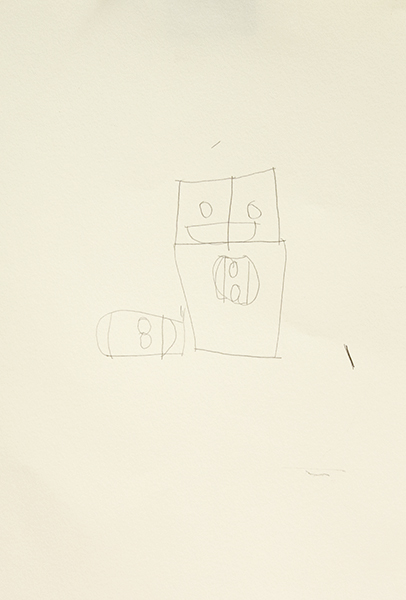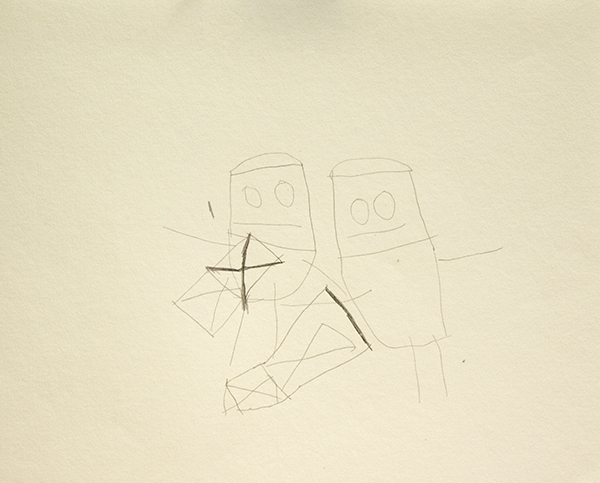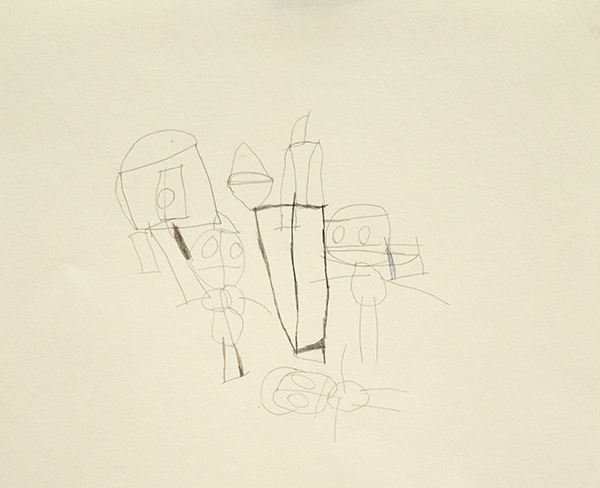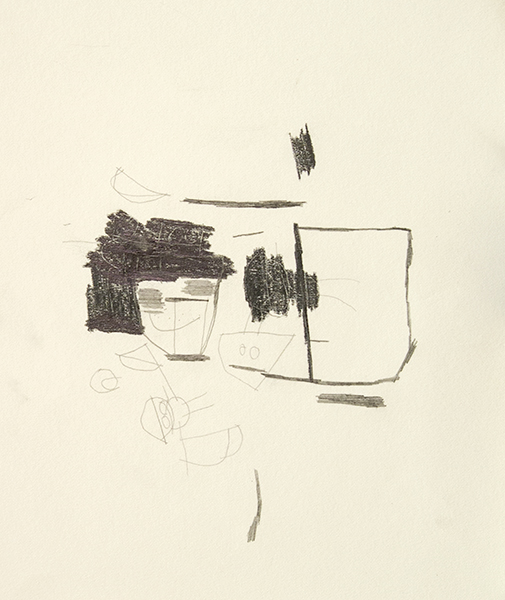Underlying Colors is a striking selection of drawings by one of Latitude Artist Community's most tenured artists, Beverly Baker, who has been supported to maintain a creative practice in their studio since its founding in 2001.
Read MoreEvelyn Reyes: Ritual, Rules, and Abstraction
San Francisco-based artist Evelyn Reyes has been diligently creating robust series of minimalist drawings at Creativity Explored for the past 15 years; over this time she has consistently maintained a presence in the contemporary outsider art discourse...
Read MoreJulian Martin
Untitled (motorbike), pastel on paper, 15" x 11", 2014
Untitled (White on Cream), pastel on paper, 15" x 11 1/4", 2010
Untitled (Orange Shape and Khaki), pastel on paper, 15" x 11 1/4", 2010
Untitled (parrot), pastel on paper, 15" x 11", 2014
Like other progressive art studio artists at the Outsider Art Fair, Julian Martin works from found imagery culled from magazines (often art publications). Whereas Helen Rae pushes found imagery to greater levels of complexity and reality, and Marlon Mullen and Andrew Hostick retell images in their own vocabularies, Martin pares the image down to a series of perfectly resolved moments in which a series of forms (each powerful and resolved in their own right), is described with an abundance of velvety pastel marks applied deliberately and seamlessly with a deft touch. Martin achieves a ubiquitous softness - soft colors, shapes, surfaces, and materials, yet always precise and controlled in application, saturating the surface while maintaining the boundaries of each form with conviction.
Initially, Martin’s work seems aesthetically akin to the work of many young artists currently revisiting concepts of early abstraction with suggestions of the figure, such as Brooklyn-based painters Austin Eddy and Tatiana Berg. However, where these artists revisit and re-imagine the ideas of artists like Picasso and Dubuffet, who were themselves appropriating the aesthetics of outsiders, Martin is the real thing. Not in that he is a “real outsider” (at this point Martin is quite well established professionally, certainly as much an insider as any artist living and working in Melbourne), but rather that his works, in sum, lack any tone of irony or nostalgia; the strength of resolution that each of Julian Martin’s drawings finds is achieved through a minimalist’s sensibility, preoccupied with the absolute rather than a historical context, more comparable to Malevich, Gottlieb, or Mondrian than Cubism or Art Brut.
The proposition underlying Martin's work seems to be that a found image may, inevitably or inherently, possess a more perfect resolution that can be exposed through a measured and thoughtful process of reduction. Unlike Mondrian, the absolute is not found in total abandonment of the original, but in the poetic and specific distillation of the identity and expression of the image.
Martin has attended Arts Project Australia in Melbourne since 1988 and has exhibited extensively at various venues in Melbourne since 1990. He has also shown previously at Fleisher/Ollman (Philadelphia), several Outsider Art Fairs (NYC), Museum of Everything (London), MADMusée (Belgium), Phyllis Kind Gallery (NYC), Jack Fischer Gallery (San Francisco), among others. Martin is represented by Fleisher/Ollman and Arts Project Australia.
Grace Coenraad
Grace Coenraad, Untitled, micron, sharpie, graphite, and india ink on paper, 2015, 16" x 16"
Grace Coenraad, Untitled, micron, sharpie, and india ink on paper, 2015, 22" x 22"
When I first painted a number of canvases grey all over (about eight years ago), I did so because I did not know what to paint, or what there might be to paint: so wretched a start could lead to nothing meaningful. As time went on, however, I observed differences of quality among the grey surfaces – and also that these betrayed nothing of the destructive motivation that lay behind them. The pictures began to teach me. By generalizing a personal dilemma, they resolved it.
Gerhard Richter, From a letter to Edy de Wilde, 23 February 1975
Coenraad’s dark, minimalist works are the product of a measured and slow process, executed with extreme diligence. Using 08 black microns, traditional pen and ink nibs, and occassionally graphite, she densely hatches careful lines, which slowly collect on the surface over many hours of work. This method is a clear path leading to an absolute resolution - the surface being obscured by black. The magic of these pieces (although they’re inextricable from the story of the steadfast execution of this simple method) lies in content that’s fantastically nuanced and complex. The black square is a subtle, jagged field comprised of various sheens and tones - certain patches are tinted by an initial application of bright watercolor (often pink or blue) that has bled through the subsequent, inevitable layer of black. The marks made using microns are incised, and those created with india ink and nib lift the paper slightly away from the surface, resulting in a textured surface reminiscent of Richard Serra’s black oil stick drawings. And much like the reductive, sublime paintings of Richter or Clyfford Still, Coenraad demonstrates that the honest act of mark-making isn’t reduced when it’s stripped of intentions or illusion. Conversely, it only becomes more revealing and mysterious.
After his first museum exhibition of entirely black drawings in 2011, Richard Serra was described by critic Roberta Smith as hermetic, abstract, difficult, and austere, an assessment that he accepted, describing it as “a virtue.” Explaining that art has to be difficult, Serra said that drawing independent of the flamboyance of color interaction, mark-making on its own, in black on white, proves to necessitate invention, thereby providing a “subtext” for how an artist thinks. For him, allover black works were a move to escape that convention of drawing as a “form to ground problem” to create works concerning “interval and space” rather than image.*
Coenraad didn’t stumble upon this principle inadvertently like Richter; for her, it’s a process that reflects a way of being. It is, as Serra articulates, an extension of the thought process and more. To a degree that’s rarely seen for non-performative artists, Coenraad is an artist for whom the boundary between life and art is blurred. Every task is executed with the same resolute sensibility, engaging life with a singular and sophisticated method in pursuit of perfection. Every bite of food is carefully selected and examined before being eaten (ingredients of an undesirable color rejected), every mundane task is afforded great consideration. For years she has worked part-time at a document destruction facility, where no one has been able to compel her to obliterate more than one document at a time. At home, blackening crossword puzzle squares for hours with ballpoint pen or sharpie is part of her daily ritual.
In the studio, Grace is fully immersed in her practice - working with her face close to the surface, she becomes absent from anything exterior of the drawing process. Occasionally she will stop and look around the room for a moment like a deep sea diver rising briefly to the surface, before submerging again. Grace doesn’t discuss her work, not because she can’t, but because there seems to be nothing necessary to say once a piece is finished.




Between her larger, long-term works, Coenraad sometimes creates small graphite sketches, thoughtful experiments that serve as a point of entry into her mysterious thought process. The placement of faces demonstrate the dynamics of orientation in her drawings. The coexistence of elements in combination with turning the paper many times while working isn’t incidental to the process, but essential to it.
Coenraad is a Juneau-based artist who maintains a studio practice at The Canvas in Juneau, Alaska. Her work will be included in an upcoming group exhibition curated by Disparate Minds writers Tim Ortiz and Andreana Donahue at The Canvas' exhibition space in December.
Carl Hendrickson
"Carl Hendrickson’s explorations of the way wood works are extravagant, magical, and yet paradoxically pragmatic. While cerebral palsy prevented him from pursuing very many projects – he communicated not in words but through emphasis of gesture and gaze– Hendrickson produced a small, strong body of work that exhibited great architectural prowess and ingenuity. His medium was primarily wood, a material with which he took infinite pains, making certain that each piece of wood was cut and fitted exactly as he had envisioned. He was one of the earliest group of artists to attend Creative Growth, beginning in 1976.
Born in the United States, 1951-2014." - Creative Growth
Evelyn Reyes
Salmon Carrots, oil pastel on paper, 2010
Orange Carrots, oil pastel on paper, 2009
Brown Carrots, oil pastel on paper, 2009, all images courtesy Creativity Explored Licensing
Evelyn Reyes has been creating powerful and minimal oil pastel drawings like these at Creativity Explored in San Francisco since 2002. The conviction and ritual apparent in her extensive series of works is definitive not only of her creative practice, but also her way of being; from Creativity Explored's website:
"Reyes’ art practice mirrors the repetition and order that are central to her daily life. Reverence for each aspect of the process defines her art practice. It begins with the selection of a piece of specifically sized paper. Next, the particular shade of oil pastel is chosen, the forms outlined then filled with a thick impasto. The finished piece is carefully examined, cradled in her arms, and taken to certain cardinal points in the studio. And finally, there is the ceremonial clean up and storing away of the completed work." (see more)
Reyes' collaborations with Bay Area artist Sarah Thibault will be included in Creativity Explored's upcoming exhibition Super Contemporary.
